There are fewer and fewer photography destinations on the planet that can be properly called “under-explored”. However, the Azores Islands are one of those places. As this guide to the best photo spots on The Azores Islands will show: this place is incredibly photogenic. But what this guide doesn’t show is the fact that the entire time I was in The Azores exploring I didn’t once see another photographer. I can’t remember the last time I had that experience.
Like all my photography guides that are destination based, this guide to the best photo spots on the Azores Islands comes with a bit of a disclaimer. I have not been to all the potential photography destinations on the Azores, nor have I been to all of the islands. However, this list of photo spots will be updated as I explore more on future trips.
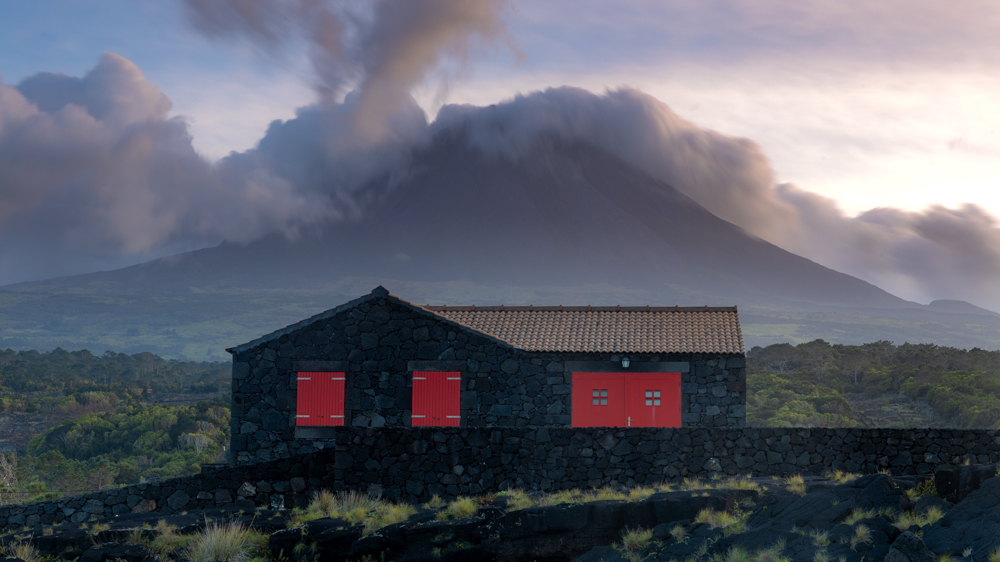
Travel and Photography Logistics for The Azores
Before we get into the photo spots in The Azores, let me give you a quick rundown on the logistics to travelling here as a photographer. Without visiting, getting around the islands seems pretty complicated. But, the truth is that the infrastructure is pretty good.
Getting Around
From island to island: It’s important to understand that the greatest challenge you’re going to have on the Azores is getting from island to island. Some of the islands are connected via the ferry system with the company Atlántico Line, but not all the islands are connected by ferry, and some are only connected a couple times a week. So, you’ll need to plan your trip in advance to match the ferry times.
The good news is that each island has an airport and there are pretty good flight connections. There are times you’ll have to hop back to Ponta Delgada to connect, but you can basically get to any island pretty efficiently.
Getting around the islands: Honestly, you’re going to need to rent a car if you’re hoping to get to lots of different photo spots on the Azores. There is little to no public transport that will help get you to photography destinations at the times you’ll want to take pictures. There are tour companies where you book a driver, but these are fairly expensive. The most common car provider on the islands is Ilha Verde rental cars.
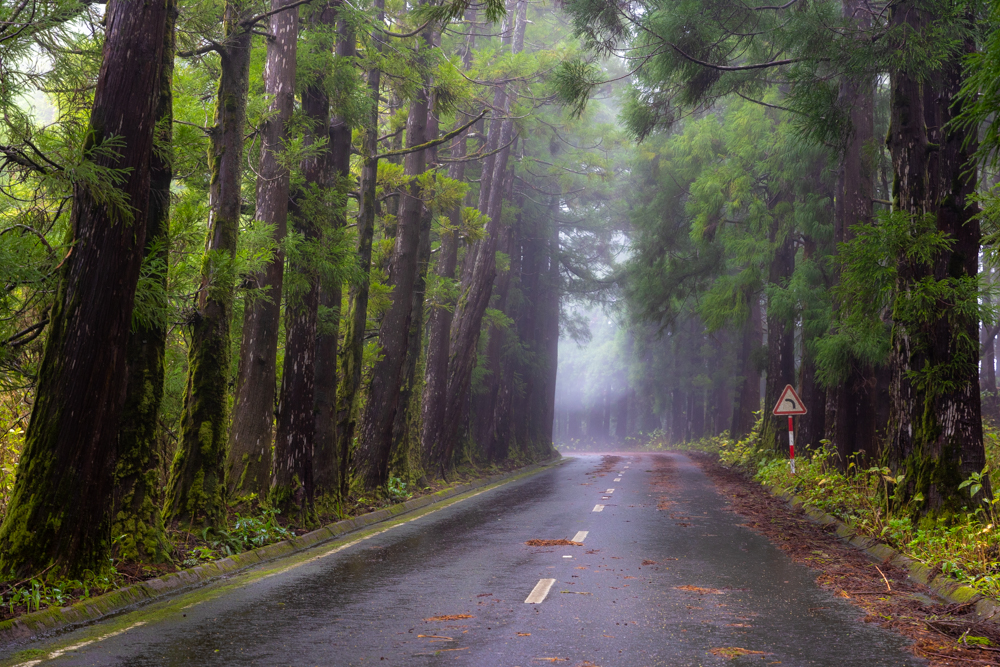
Accommodation
I was surprised by the quality and fairly reasonable price of accommodation in The Azores. I’m not sure if it’s just because we were there way off-season, but it was reasonable. In one case we managed to get a 4-star hotel for a price that I would call mid-range.
Moreover, you do have a wide variety of accommodation types. There are a few hostels in the bigger towns, but not as many as might expect.. The best budget option on the islands are the guesthouses. They can run from about 30-50 Euros a night in the low season and 50-80 Euros a night in the high season.
There are quite a few good hotels around the islands too. Look for a budget of around 50-90 Euros a night in the low season and 90-130 during the high season.
For those looking to camp, there are plenty of campsites around the various islands. Most of the campsites are fairly well equipped and very safe.
The Weather of The Azores
I would say that the weather of The Azores kind of resembles Iceland without being so cold.
Set way off in the Atlantic Ocean means that The Azores are regularly hit by passing weather and storms. According to locals, the spring tends to be the safest time to visit – in regards to good weather. The summer is also pretty good. The fall can bring violent storms that are basically the off-shoots of hurricane season in The Caribbean. The winter is hit or miss.
For photographers, I’d aim for the spring. Winter can also be incredible, but you might fight a passing storm or two and need to be patient.

Camera Gear
I laughed a little bit when I looked at my photo data from my most recent photography trip to The Azores. Of the 156 photos I took, 120 of them were taken between 14-35mm. I could have almost done the entire tour with just one lens.
That being said, I do think that you’ll want 3 lenses.
- Ultra-Wide: Something like a 14-35mm or 16-35mm will get a lot of use on the seascapes of the Azores.
- Standard Zoom: I used my 24-70mm quite a bit, I think it’s a required lens, almost, for the Azores.
- Tele-photo: I also brought my 70-200mm f/2.8 lens and though I used it sparingly, I probably could have used it more often.
I would also say that if you’re into birding, you’ll want something like a 100-500mm lens.
If you’re doing landscape photography and using a tripod, you’ll definitely want to make sure whichever tripod you’re using is sturdy. There can be some pretty wild winds here on The Azores Islands, and if you bring a flimsy tripod it might get knocked over; causing damage to your lens.
The Photo Locations of The Azores Islands
I’m going to try to list the best photo spots on the Azores Islands islands-by-island. The photos in this guide were all taken on a 7 day trip to the Islands and we were hit by some pretty sub-par weather. So, not all the photos match the potential of the locations
Sao Miguel
I was a little bit worried that Sao Miguel would be short of photo locations. That’s definitely not the case. There are dozens. We hardly scratched the surface. In fact, even the city of Ponta Delgada has so many opportunities for street photography.
These are some of my favourite photo spots on Sao Miguel.
A Porta do Diablo is a really cool photo spot on the far west side of the island. There are a number of photos to be made at this location. One of my favourite is of the volcanic sea arches and crashing waves.

There’s also a beautiful old building with a swimming pool that’s set in front of the stunning green cliffs.

My next favourite location is up in Nordeste which, as the name implies, is up in the north-east corner of Sao Miguel. We found this photo spot location scouting the area and were blown away by it. In fact, I think there are about 4 different photo spots within this one location.
The first is up on the viewpoint looking down on the lighthouse and the seascape.

The next is down on the road that leads to the lighthouse. Down there, there’s an incredible view up the coast and a waterfall that dangles off the side.

There’s also the fishing village and port down below it all. The road that winds down the steep slope is beautiful. Note: don’t try to drive this. It’s very steep.
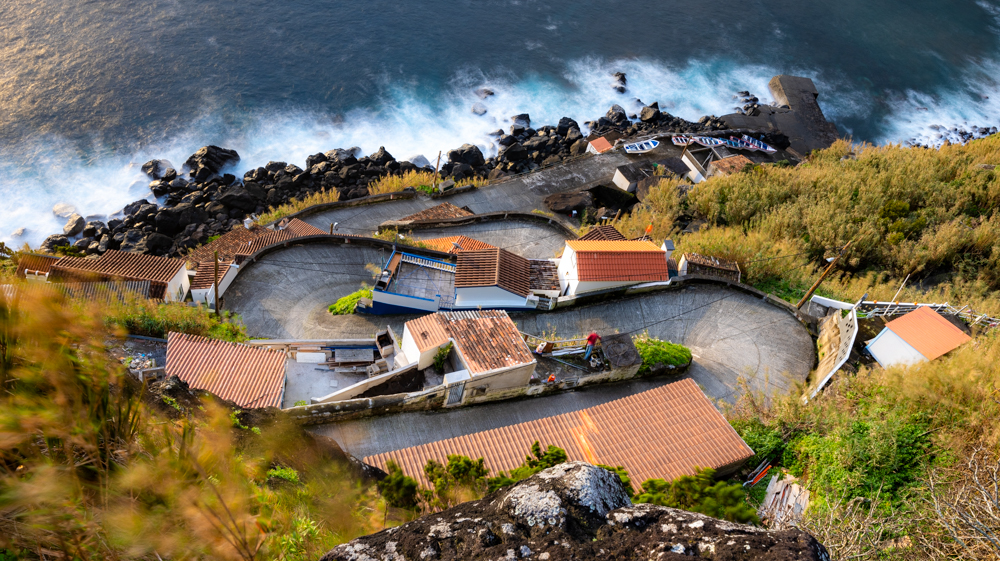
If you have a wide enough lens (I used a 14-35mm f/4 Canon lens), you can grab the winding road, village, and the beautiful coastline all in one frame.
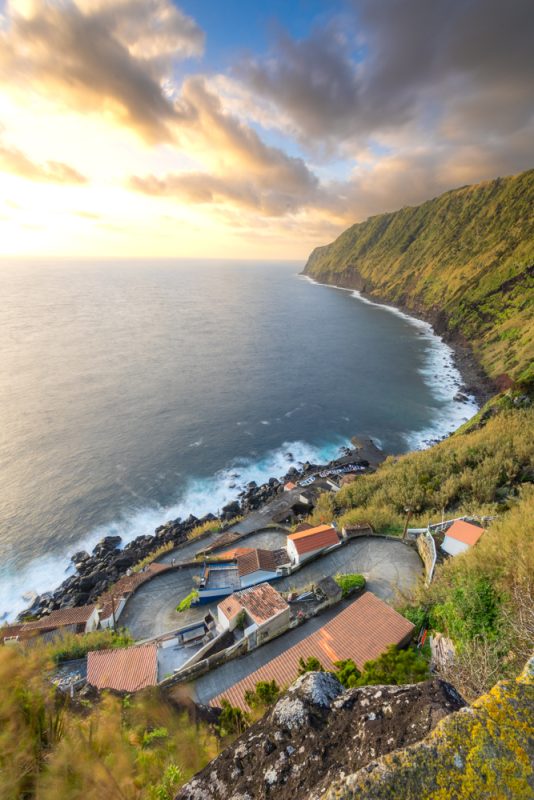
Miradouro da Boca do Inferno is the next great photo spot on Sao Miguel. It’s a pretty popular tourist spot as well, so you won’t be alone.
To get here, you’ll need to hike about 20 minutes on an old road through a forest. Then, it’s a pretty easy climb up to the view. I think the vertical climb couldn’t be much more than 20-30 meters.
At the top, you’ll be rewarded with a pretty epic view of multiple caldera.

Miradouro da Vista do Rei is the other viewpoint of the caldera. The location is up next to an abandoned resort. When we were there we didn’t have great weather.

Pico Island
For me, Pico Island was the most photogenic island we visited in The Azores. There were countless photo spots on this island alone. Sadly, we were hit with the worst part of an Atlantic storm when we were here and didn’t get to make it to a number of the photo spots we’d intended on scouting and photographing.
However, we did make it to a couple.
Arcos Vulcânicos on the north side of the island is a photographer’s dreamscape. The name means “Volcanic Arches” due to the fact that the ancient lava flow has dropped into the sea and created arches. These archest themselves are likely pretty good photos.
However, I was really focused on the beautiful lava-brick houses with red shutters that stand in front of the volcano.

I found 2 or 3 different compositions of these houses. I think I probably could have spent 3 or 4 sunsets at this location and still not had enough time to properly photograph it.
Manhenha was one of the towns we scouted during some bad weather and I was impressed. From the rocks in the harbour of town you can use Farol da Ponta da Iha as the backdrop to your images here.
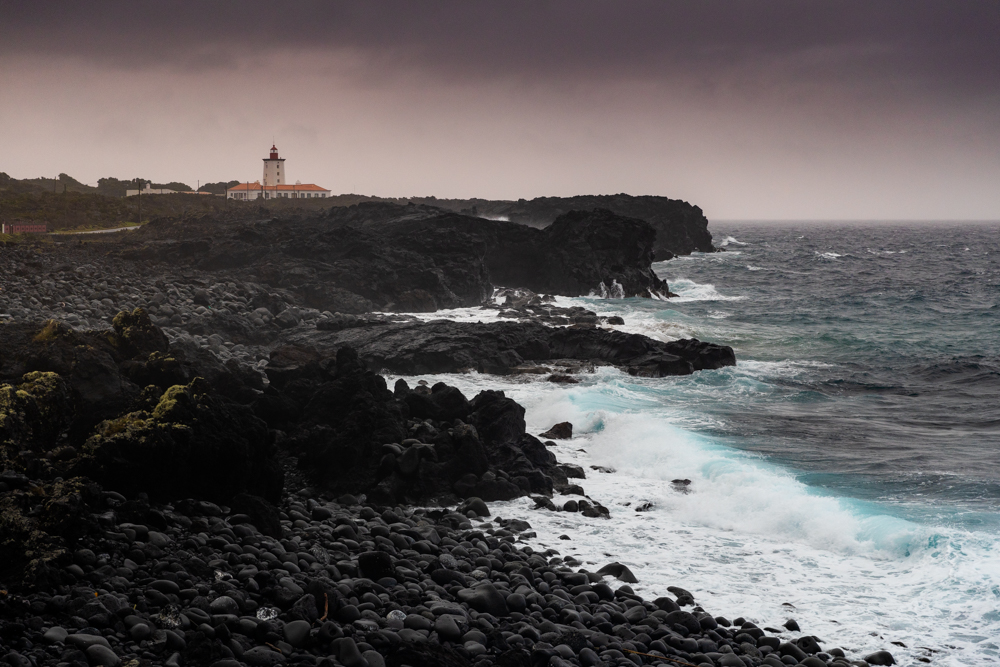
Despite really bad during the sunrise photoshoot here, we managed to get a couple decent images. It’s definitely one of the places I want to come back to.
Ribeiras is another town with lots of potential. There are a number of waterfalls that tumble town the cliffs into the sea here. Again, we were battered with bad weather, but the potential is obvious.
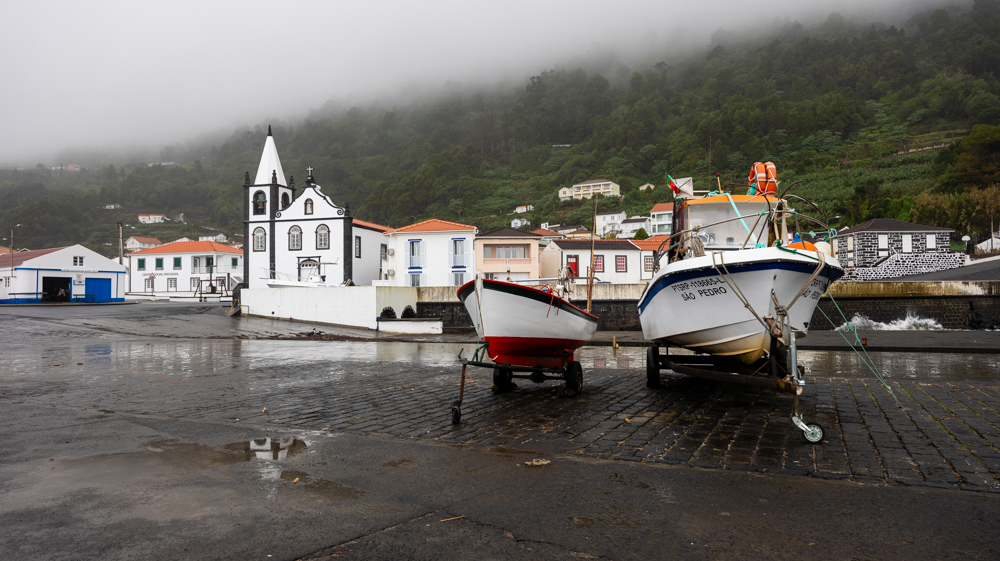
Finally, we found some pretty cool scenes at a place in the south of Pico Island called Zona Balnear Ponta do Admoiro. It’s a place that will go on my list of spots I need to go back to and photograph again. There’s also definitely some photos of the incredible vineyard fencing in the south of Pico, but we didn’t have time to photograph them.
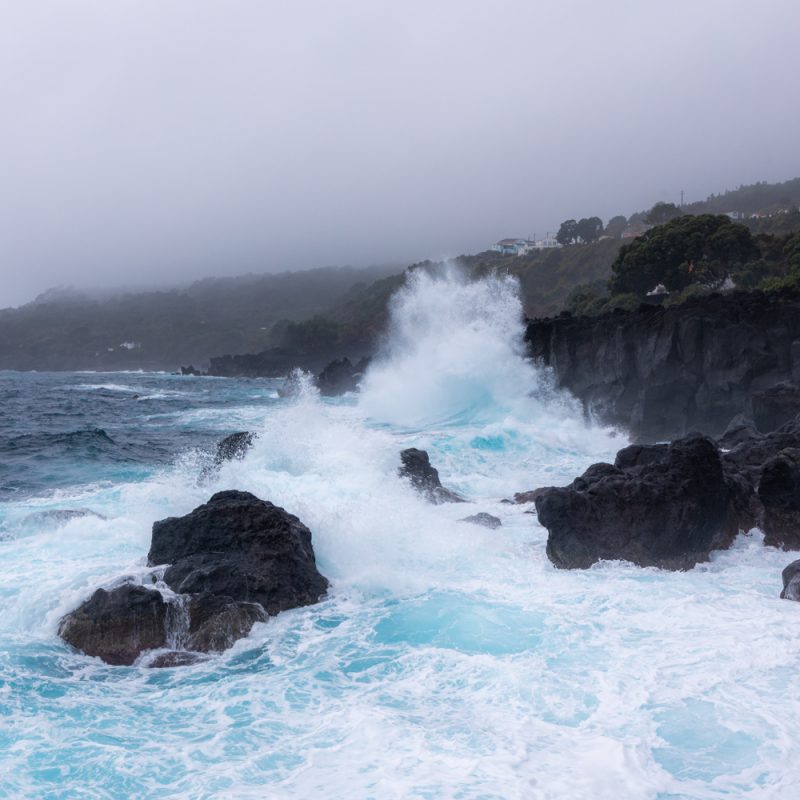
Faial Island
We flew from Ponta Delgada to Faial Island and honestly didn’t plan to explore it too much. I had a couple of photo locations that I wanted to scout while there, but I was probably the least excited about it.
But after exploring I can confidently say that there is definitely a day’s worth of photo spots on Faial.
Farol da Ponta dos Capelinhos is definietly my favourite photo location on Faial Island. Basically, it’s an abandoned lighthouse set in an epic bit of landscape surrounded by volcanoes. I think the best photo here would likely be a drone photo. However, the wind was too strong here for me to get my drone up.
I’m still pretty content with the photos I did get here.
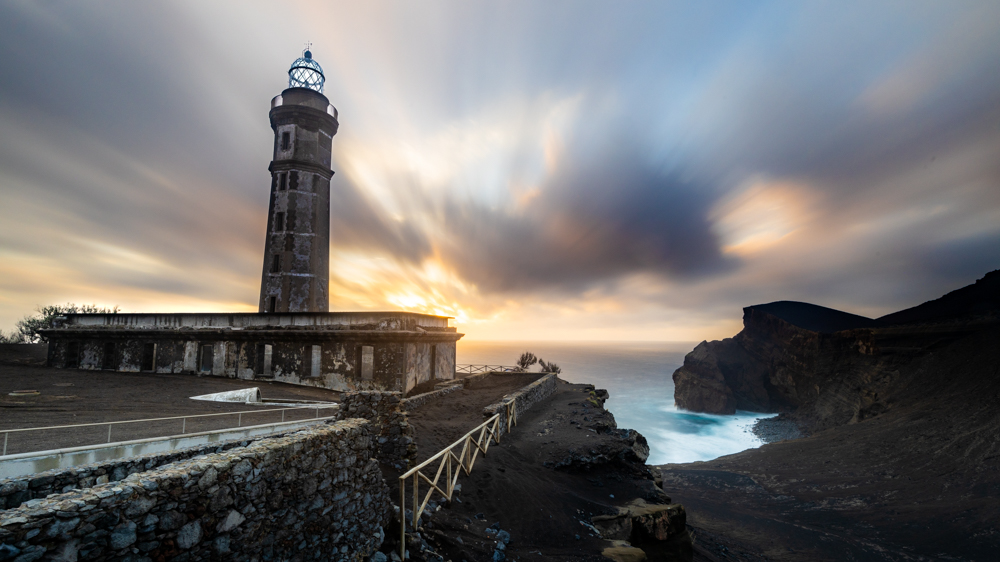
Just east of Miradouro Ponta Furada there’s a small parking lot next to a sea arch that also makes for a pretty good photo spot. The light wasn’t great when we were there, but it’s definitely worth a stop.
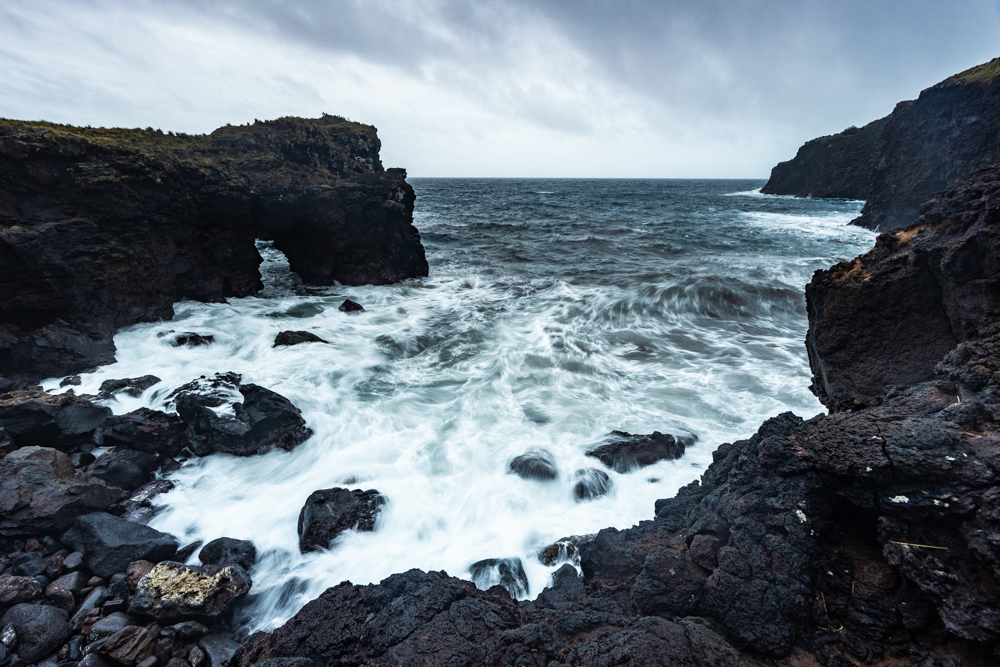
There are also a number of other locations that are worthy of photographs here on Faial. We went up to Caldeira do Cabeço Gordo but there was so much fog and rain we couldn’t even see the bottom. It is a pretty incredible place though.
Farol da Ponta da Ribeirinha is another abandoned lighthouse that was destroyed by an earthquake. I think it would be a pretty cool astrophotography location.

Flores Island
One of my great regrets is that I didn’t make it to Flores Island on my scouting trip of The Azores. Based on photos I’ve seen online, Flores might actually be the most photogenic of all The Azores.
Photography Tour of The Azores
Speaking of Flores, it will be included in the itinerary for my next Azores photography tour. I’ll be leading a tour here in 2025 and it’s setting up to be pretty brilliant. I cannot get over how beautiful the islands are, and I can’t get over how many really amazing photo spots there are here.
If you’re interested in joining me on that trip, check out this page for more info.
And, if you’d like information on my other photography tours and workshops as they’re released, be sure to sign up to my newsletter below.
